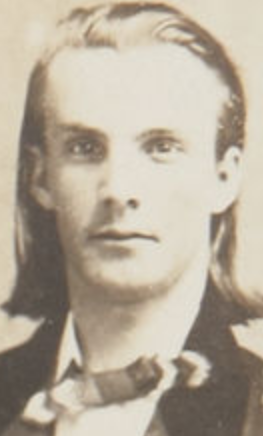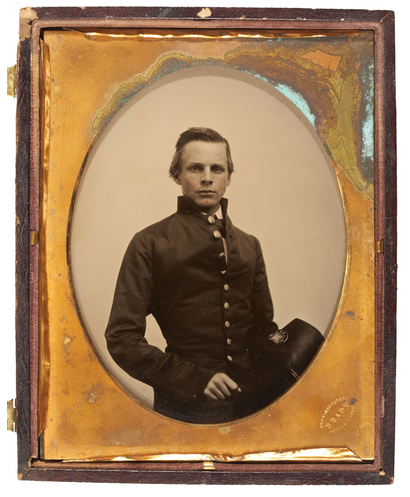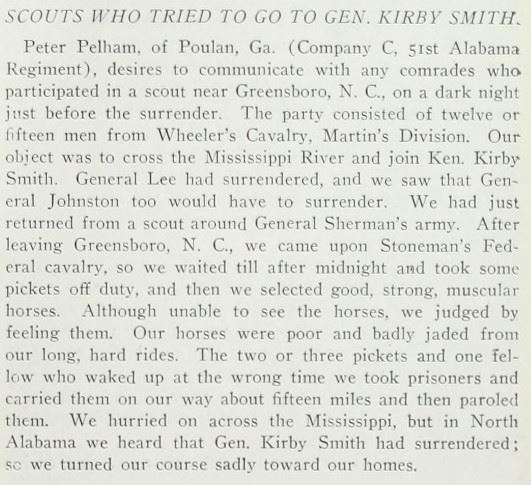

The Union colonel looked at the young Confederate private dressed in citizen’s clothes. The private was facing a death sentence for being a bushwhacker. He had fired on Union soldiers, was by himself, wore no uniform, had nothing that identified him as a Confederate cavalryman. Everything indicated he was a bushwhacker.
The only thing the earnest young man had in his defense was his word that he was indeed in Confederate service and had become separated from his unit while looking for his wounded brother.
The colonel held the young man’s life in his hands. He asked some questions: Did he know John Pelham and details about John’s life?
Then, the colonel turned to the court and said, “‘I believe this boy is telling the truth. I know John Pelham; we were together at West Point last year, and I know John Pelham would not tell a lie under any circumstances; this boy describes him perfectly and looks like him.’”
The court declared the young Confederate innocent of bushwhacking.
Imagine your life being saved because of the honorable character of your brother! I wanted to know more.
The “Gallant” John Pelham, the man with honorable character, I already knew. I learned about his younger brother, Peter. I wanted to know more about the colonel who testified on behalf of an adversary. He was said to have been a classmate of John and was with him in 1861.
I thought he must have been a remarkable man for the other members of the court marshal court to give so much weight to his opinion – not eyewitness testimony, mind you – his opinion. The officer risked his reputation and spoke on behalf of a man he didn’t know.
Intrigued, I set out to find out who he was and give him credit for his chivalry. I hoped he survived the war and lived a long and happy life.
No Student at West Point Named Gilham
First stop in my investigation of the colonel’s identity was West Point. Their helpful researcher emailed back almost immediately: There was no student named Gilham at West Point in 1861. In fact, there never had been a student named Gilham at The Point.
Discovering that there was no Colonel Gilham who had been a schoolmate of John Pelham, I wanted even more to solve the mystery of the Union officer’s identity.
There were a few known facts about the man. According to Pete, Gilham was
- From Gainsboro, TN, northeast of Nashville
- A colonel who later became a general
- With John Pelham at West Point in 1861
In 1924 Pete’s friend former Michigan governor Chase S. Osborn wrote a memorial tribute to Pete in the Confederate Veteran and mentioned the anecdote and Gilham.
“It took little time to convince the officer, who announced he had been a classmate at West Point with John,” Osborn wrote. “The officer took him (Pete) to Nashville, found a captured uniform for him, and paroled him, October 9, 1862.” That was two days after Pete was captured.

No doubt Governor Osborn believed what he wrote, but his account does not agree with Pete’s, which states that the court martial took place in the capitol in Nashville, which means Pete didn’t go to Nashville afterward. Additionally, Pete writes that he was paroled two weeks later.
“The prison was outside of the city,” Pete remembered. “General Forrest was in command of the Confederate troops around Nashville, and I understood that the Federal commander in Nashville at that time became uneasy for fear Forrest would make a raid on the prison and release all the prisoners, so they paroled all of us, some two or three hundred.”
Governor Osborn can be forgiven for mistakes in a few details when recalling an incident told to him by a friend (there is no evidence, as far as I know, that Osborn was present at the time of Pete’s trial), the event taking place 62 years previously. The anecdote was only a sidelight to the overall theme of Osborn’s article, a tribute to Peter Pelham’s life.
But apparently Governor Osborn either misunderstood Pete or just assumed that John and the colonel were classmates because they were together at West Point. Neither Peter nor the colonel says they were classmates. Pete only quotes the colonel as saying he was with John at West Point in 1861.
A Likely Candidate
Not finding Colonel Gilham in John Pelham’s class, I tried a long-tail search of the Internet: Gilham West Point graduate serving in Nashville who became a general. And Google helpfully asks, “Do you mean Gillem West Point graduate serving in Nashville who became a general?”
I most certainly did mean Gillem! To be precise, Alvan Cullom Gillem, an 1851 graduate of West Point who was born in Jackson County, TN, in 1830. Gillem graduated 11th in a class of 42 at the academy.
Immediately after graduation Brevet 2nd Lieutenant Gillem began a distinguished military career that took him from coast to coast, interestingly beginning and ending with wars with Native Americans. Initially, he served with the 1st Artillery in the Florida hostilities against the Seminole Indians. Then, he was stationed at numerous posts, from the Texas frontier to Key West Barracks, FL, until the outbreak of the Civil War.
But Gillem already had graduated when John enrolled at West Point in 1857 and he never was stationed at West Point after his graduation. If Gillem is the man who saved Pete’s life, how could he have been at West Point with John Pelham in 1861?
It seems most likely that Gillem’s path crossed that of John Pelham in 1858 during his brief tenure at Fort Columbus (renamed Fort Jay in 1904), NY, only 48 miles south of the academy on the Hudson River.

Gillem was stationed at Fort Columbus after he became ill when stationed in Baton Rouge, LA, in 1853. Randy Bishop says in his book Civil War Generals of Tennessee that Gillem’s illness prevented him from serving most of 1853 and 1854.
Recovering from Yellow Fever, Gillem served from 1854 to 1856 at Fort Monroe, VA, where he met his future wife and married, and from 1856 to 1858 at Fort McHenry, MD. His assignment at Fort Columbus, also in 1858, was short because that same year he got orders for frontier duty at San Antonio, TX.
When his orders came, Gillem must have known he probably would not have another chance to visit the academy for a long time. If he was going to West Point, he must have thought he’d better do it before he went west. Perhaps, he wanted to show the grounds to his new wife.
Who hasn’t returned for a sentimental look at the school that sent them off to conquer the world? It would have been seven years since Gillem’s graduation and West Point was only 48 miles away. I can imagine it, can’t you? And John Pelham was in his second year at the academy in 1858.
I wonder if Gillem, a 28-year-old combat veteran in the artillery, and Cadet John Pelham, whose bravery as an artillery officer during the War Between the States would earn him the sobriquet “the Gallant Pelham,” talked about the big guns when they encountered each other at the academy.

But there is a problem. Pete quoted the Union officer as saying he was with John “last year” – that would have been 1861 – and Gillem was at Fort Columbus in 1858. Still, Pete could have been wrong about the colonel’s exact words. I’m not sure I could quote someone exactly after 62 years regarding a time when I was close enough to eternity to hear the singing.
Matching Up Other Details
So, where was Alvan Gillem and what was his rank at the time of Pete’s trial?
On the morning of Oct. 7, 1862, when Pete was taken prisoner, Gillem was colonel of the 10th Tennessee Volunteers stationed in Nashville. Gillem was provost marshal of the city of Nashville (Aug. 12 to Dec. 24, 1862) at the time of Pete’s capture and trial.
Gillem comes close to fitting Pete Pelham’s description:
- Pete’s rescuer was born in Tennessee; Gillem was born in Gainesboro, TN, northeast of Nashville.
- Pete’s rescuer was a West Point graduate and colonel at the time of Pete’s capture.
- Gillem was provost marshal of the city of Nashville at the time of Pete’s capture and trial (Aug. 12 to Dec. 24, 1862) and was likely to be part of the military court.
- Gillem rose to the rank of major general.
- His opinion carried weight. He not only was provost marshal in Nashville but was breveted in January 1862 for gallant and meritorious services at the Battle of Mill Springs, KY, in command of General George Thomas’ siege artillery.
- Gillem sounds like Pete’s spelling, Gilham.
It seems likely that Colonel Alvan Gillem is the officer who vouched for Pete based on what he knew of John’s character.
Colonel Gillem’s Service During the War
Colonel Gillem subsequently commanded a brigade in combat and was adjutant-general of the State of Tennessee charged with guarding Nashville. He was brigadier-general of US Volunteers on Sept. 4, 1864, when he commanded the troops in the action in which Confederate General John H. Morgan was killed in Greenville.
Gillem was a member and vice president of the Convention to Revise the Constitution and Re-organize the State Government of Tennessee in January 1865 and was a member of the Tennessee House of Representatives in March of that year.
In April 1865 Gillem commanded the 1st Cavalry division in Major General George Stoneman’s raid through Virginia and North Carolina, the longest cavalry raid in the history of the US Army. Gillem was brevetted major general of the US Army for gallant conduct at the battle of Salisbury, NC.
An Encounter at the Close of the War
Peter Pelham and then-General Gillem came close to brushing shoulders again near the end of the war, though neither of them may have realized it. Pete wrote in the January 1913 issue of Confederate Veteran how he and other scouts tried to continue fighting rather than surrender. They needed horses.

I wonder if Pete knew he was riding one of General Gillem’s men’s horses home to Alabama. It’s likely he did because the men usually knew whose troops they were facing.
Reconstruction and Post-War Service
General Gillem’s service to the Union continued during Reconstruction. He was placed in command of the District of East Tennessee. He was mustered out of volunteer service in September 1866, retaining the rank of colonel of the 24th Infantry in the regular army.
General Gillem commanded the Fourth Military District, overseeing federal occupation of Mississippi and Arkansas, which brought criticism from Radical Republicans, many of whom thought he was too lenient with former Confederate officers and freed slaves.
A descendant of General Gillem believes there’s a reason his ancestor might have been lenient. The people in Mississippi and Arkansas were experiencing a severe drought during the time he was commanding the 4th Military District. The economy was bad and the people were trying to get back on their feet.
“He was just a country boy when he was appointed to the academy,” he says. “He probably knew what it was like to try to make a living.”
General Gillem’s compassion got him reassigned to frontier duty at Galveston, TX, and Fort Concho, TX.
In 1870 he was transferred to the 1st Cavalry and stationed at Benicia Barracks, CA, where he commanded troops against the Modoc tribe in northeastern California and southeastern Oregon in 1873.
It was there that General Gillem suffered another debilitating round of ill health. Gillem was one of the officials authorized by Washington to meet with representatives of the Modocs on April 11, 1873, to try to avert further fighting.
General Gillem, battling with his old physical enemy, was confined to his tent, too ill to attend the meeting. The family story is that he contracted dysentery at Shiloh and never recovered from it.
His illness saved his life. The Modocs ambushed the peace commissioners and Major General E.R.S. Canby and Reverend E. Thomas were killed and another man wounded.
After the Battle of Sand Butte on April 26, 1873, there were calls for General Gillem to be removed. He was relieved by the new department commander, Brigadier General Jefferson C. Davis, who personally took command.
General Gillem became seriously ill and partially paralyzed in 1875. While on convalescent leave at the Soldier’s Rest home near Nashville, General Gillem died on Dec. 2, 1875. He was only 45 years old. He is buried at Mount Olivet Cemetery in Nashville.
General Gillem’s Legacy
Besides his honorable service record, Major General Gillem left a legacy to his country in the form of his descendants.
Among them are
- 11 members of the US military, who have served in conflicts spanning the Spanish American War, World Wars I and II, Vietnam, Iraq and Afghanistan, and some of whom are currently in active service.
- one captain, three lieutenant colonels, three colonels and two lieutenant generals
- two US Military Academy graduates, two US Air Force Academy graduates and one cadet at the US Coast Guard Academy
These descendants, who requested anonymity, have had illustrious careers in the US military, to which their awards and honors bear witness.
To Whom Honor Is Due
Colonel Gillem and the Pelham brothers lived in a time when society as a whole considered it dishonorable to tell a lie, to break one’s word, to be unjust, to cheat a friend or foe. Generosity and mercy were inherent in a man’s honor.
Colonel Gillem demonstrated his own character when he not only spoke up for an adversary when he thought it was right, but he also protected Pete from again being mistaken for a bushwhacker by personally seeing to it he had a proper uniform to wear.
That kind of gallantry should be recognized.
My search for the Union colonel led me to his family, remarkable for their outstanding service to the United States, continuing to the present time. General Gillem’s descendants helped write the military history of this country, influencing the America we live in today.
By Pete’s own account in The Confederate Veteran years later, Colonel Gillem’s faith in him and his brother was not misplaced. Pete had told the truth. He was not a bushwacker. He was a Confederate private who got separated from his unit.
I appreciate the cooperation of General Gillem’s descendants in providing information for this article. It is possible I have inadvertently omitted a descendant whose service should’ve have been recognized. If so, please comment on this post, include the individual’s service record and your relationship to this person and I will be happy to correct the error.
If you would like to join the John Pelham Historical Association, created to perpetuate the memory of Major John Pelham, please see the association’s Facebook page. I am a member.
Other Posts About Major John Pelham
John Pelham in the Crucible at West Point
Privations Began Early for John Pelham and Stuart’s Horse Artillery
Major John Pelham’s Character Saves the Life of His Brother Peter
Sources
Chase S. Osborn, Governor. “Maj. Peter Pelham – A Tribute.” Confederate Veteran, Vol. XXXII, No. 6, June 1924: p. 236-237.
Peter Pelham. “An Unfortunate Shot.” Confederate Veteran, Vol. XXX, No. 5, May 1932: p. 171-172.
Peter Pelham. “Scouts Who Tried to Get to Gen. Kirby Smith.” Confederate Veteran, Vol. XXI, No. 1, January 1913: p. 19.
Randy Bishop. Civil War Generals of Tennessee. Gretna, LA: Pelican Publishing Co., 2013. p. 89.
Images
Cadet John Pelham. Courtesy of Heritage Auctions, heritageauctions.com.
Major Peter Pelham in Later Years. Closeup of the original photograph. Courtesy of Heritage Auctions, heritageauctions.com.
Major General Alvan Cullem Gillem. PD-US.
Peter Pelham. Closeup of the original photograph. Courtesy of Heritage Auctions, heritageauctions.com.
Peter Pelham. “Scouts Who Tried to Get to Gen. Kirby Smith.” Confederate Veteran, Vol. XXI, No. 1, January 1913: p. 19.
Thomas Petingale. Map of the Rail Roads of the State of New York showing the stations, distances and connections with other roads. Buffalo, NY: Thos. Pentingale, L.P. Behn, 1858. Library of Congress Geography and Map Division. G3801.P3 1858. P4. Closeup.

Thank you for writing this story and giving insight into gen’l Gillem.Yearly we have a “ ghost walk” to memorialize native jackson countians here in gainesboro. It’s a delight that we can add him this year and have such a wonderful insight into his character. Jackson County and gainesboro is mountainous country and was made up of of poorer subsistence farmers that were impacted greatly by the war.Gen’l Gillem would have indeed been aware of the hard life the common folks endured as it was his heritage as well. God bless him for his humanity and honor.
LikeLike
I am glad you enjoyed the blog post. General Gillem’s descendants have contributed greatly to the United States military up to the present time. The whole family is exceptional.
LikeLike